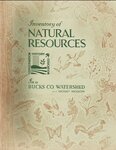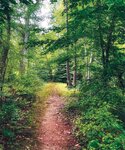


At the 50-year benchmark, the Bucks County Audubon Society realized it was time to revise “The Inventory of Natural Resources at Honey Hollow,” which it had created in 1972. The 2022 inventory in print was released in April, this year.
Honey Hollow, in Solebury Township, is a National Historic Landmark, the first watershed in the United States to utilize soil conservation practices of contour plowing and water diversion terraces as a way to prevent fertile topsoil from draining into local waterways.
The inventories of natural resources done 50 years apart, show what part of nature is surviving, who is adapting, what is evolving, and what might disappear. We are fortunate that the society made that effort long ago to record what members saw in nature. That older record in relation to the new helps us to see that changes have indeed occurred — in a short time span.
Sally Conyne led volunteers in gathering statistics on the natural resources of the Honey Hollow Watershed. The numbers undeniably reveal changes to bird and mammal counts, plant life, tree growth, insect populations, soil, water and reptiles.
In the book Conyne recounts an observation: “My mother loved every moment and detail of preparing for my sister’s wedding in 1972. It was outdoors in the garden and, just as planned, had the peak of lilac bloom as a backdrop — May 16th. This year, 50 years later, the scent and sight of lilacs on May 16th were a memory because their bloom peaked between April 26 and 30th depending where you live in and around Bucks County.
“The signs of climate change are often subtle and easy to overlook without markers and record keeping. More and more, however, the impacts are being noticed and highlighted. Birds, bats and insects are migrating earlier in the spring and later in the fall. The birds are laying eggs earlier and insect hatches are happening earlier and, in some cases, more frequently. Gardening dates are shifting ... and the list continues.”
We all feel the changes but a collection of data assures us that the observation is not our imaginations at work.
Conyne observed: “The average temperature in Bucks County between 1967 and 1972 was 50.72°F. Between 2016 and 2021, it was 54.4° — an increase of 3.68 degrees. This is a major increase over a relatively short period of time and it’s statistically highly significant. This means that average temperatures we are now experiencing are similar to those experienced in Baltimore 50 years ago. Our averages from those good old days are now the norm in Cleveland and Hartford. Our average high and low temperatures — 61.15° and 40.26° in 1967-1972, 64.43° and 44.35° in 2016-2021 — reflect a similar trend.”
Temperature change, she wrote, impacts virtually every element of the world we live in.
When she embarked on the inventory project in 2019, Conyne said, “It was immediately complicated.”
The production involved about 40 volunteers, with about a dozen lead people and two part-time staff.
The first two years were devoted to collecting and crunching numbers. Conyne doesn’t remember how many hours it took but it must have been thousands. Then came the editorial effort — organization of data, writing, collecting and creation of images, focusing on consistency of style, design, layout, indexing and, finally, printing.
“There’s a lot of talent out there,” Conyne said last week. “People volunteered. They had skills, knowledge.” Some were surprise contributors, like local caterer Jamie Hollander, who supplied information about mushrooms. Carolee Caffrey, Luke Smithson and Dennis Waters created an article on fungi and lichens.
Caffrey’s hand is visible in the writing of several articles. A behavioral ecologist, she worked with Deray Burton, Bob Reiser, John Lisowski and Nick Macelko on “In the Waters and Nearby”; on plants with Richard Radis and Ryan Schmidt; on insects with Doug Wechsler, Michael Pirrello, Chris Alics Kratzer and Paul Guris; and with Kyle Loucks on reptiles and amphibians. Caffrey wrote the section on mammals.
Other contributors to the book were Phil Getty on hydrogeology, and Mervin Stiles and Malcolm Crooks, on soil and water. Margie Rauscher-Charney, a kind of Renaissance woman, was in charge of trail cameras that caught sight of some elusive local residents, and she created colorful site maps. Lars Crooks, a third generation representative of the Crooks family, which owned the watershed, served as consultant on farm history.
John Mertz, one of the original inventory authors, wrote of the founding of the Bucks County Audubon Society in 1968 with Ray Hendrick, Forrest and Malcomn Crooks, Francis Fitting, Forrest Coburn and Alston Waring. Florence Schaffhausen’s columns in local newspapers did much to inspire the Bucks County community to get behind the Audubon efforts. The organization grew with the help of Delaware Valley College (now University).
With the Honey Hollow site acquired, one of the first steps in establishing an education center was conducting an inventory of what was living and growing there.
“In thinking about these statistics, it’s important to keep the concept of ‘50 years’ in perspective,” Conyne said. “While it seems like a huge amount of time, a lifetime, since my sister was married, those 50 years are a tiny blip by Earth history standards and that’s a lot of change for such a miniscule jot of time. Virtually every element of the world we live in is impacted in some way by these changes. People react and take appropriate steps to cope in the best ways possible.
“The natural world does the same thing — earlier migration, altering food sources, evolving a lighter coat and better heat tolerance, etc. Those who succeed survive and those who don’t, languish or disappear.”
The inventory project was enabled by a grant from the Pa. Department of Conservation and Natural Resources and donations from The Burpee Foundation, Marshall-Reynolds Foundation, The McLean Contributorship and the Bucks County Tourism Grant Program.
The Bucks County Audubon Society will host “Wine at Sunset,” featuring Honey Hollow past and present, from 7 to 9 p.m. Friday, June 7, at the nature center, 2877 Creamery Road, New Hope 18938. Reservations at $50 can be made at 215-297-5880. Copies of the Inventory will be available. It can be purchased at bcas.org.
Join our readers whose generous donations are making it possible for you to read our news coverage. Help keep local journalism alive and our community strong. Donate today.